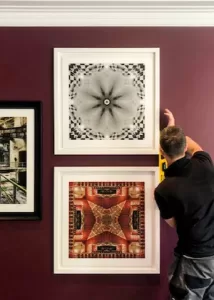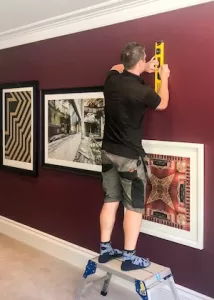





The most effective way to hang pictures
Hanging pictures, prints, and framed photos is a great way to add a personal touch to a room. It can make a real statement and help a house feel like a home. Here are a few guidelines you should follow to get the most impact from your artwork.
How high should you hang a picture?
The proper height to hang a picture is generally considered to be 57-60 inches/144-152 cm from the floor to the centre of the artwork. This is considered to be the average eye level, so it will ensure that your artwork is seen and appreciated by everyone who enters the room. However, there are a few factors that you may want to consider when determining the proper height for your pictures.
- The height of the furniture in the room. If you have tall furniture in the room, you may want to hang your pictures a little higher so that they are not obscured.
- The overall composition of the room. When hanging multiple pictures, consider how they will work together to create a cohesive look. You may want to group them together by size, color, or theme.
- Your personal preference. Ultimately, the proper height to hang a picture is a matter of personal preference. Experiment until you find a height that you like.
How to hang a picture on plasterboard
The type of fixings you use to hang a picture depends on its size and weight, and the type of wall you have.
- For lightweight pictures, you can use a simple two-pin picture hook.
- For heavier pictures, you will need to use a stud detector to locate the studs behind the plasterboard. Driving the fixings into the stud provides much more security for a heavy painting or print.
- It is possible to hang a heavier picture into plasterboard that is in good condition if you use the right fixing, such as a hollow wall anchor or a self-drill screw.
Once you have decided where you want to hang your picture, use a stud finder to locate any pipes or cables behind the wall. Then, measure the distance from the ceiling to the top of the frame and lightly mark the wall with a pencil where the top center of the picture will be.
Tighten the hanging cord or picture wire until it is taut. Then, measure the distance from the top of the frame to the cord or wire. This measurement will determine the length of the cord or wire you need to cut.
Now that you have marked the center of the wall, use the drop measurement to determine where the fixing should be placed. Mark this spot on the wall.
Now that you have measured and marked where you want your picture to be, you can follow the instructions below for hanging pictures on different types of walls and using the appropriate fixings.
How to hang multiple pictures
Gallery walls are a great way to add personality and creativity to your home décor. However, hanging multiple pictures can be tricky. Here are a few tips to help you create a gallery wall that looks its best:
- Start by placing the first picture at eye level. This will be the focal point of your gallery wall, so it’s important to get it right.
- Work from there, keeping the prints evenly spaced from each other. A good rule of thumb is to leave about 2-3 inches of space between each picture.
- Use pieces of paper as templates for each picture. This will help you to visualise your gallery wall and make sure that the spacing is correct.
- Be creative with your layout. There are no hard and fast rules when it comes to gallery walls. Experiment with different layouts until you find one that you like.
- Don’t be afraid to mix and match frames. You can use different sizes, shapes, and colours of frames to create a unique and stylish gallery wall.
Here are some additional tips:
- Consider the overall composition of the room. When hanging multiple pictures, think about how they will work together to create a cohesive look. You may want to group them together by size, color, or theme.
- Use a level to make sure that your pictures are hung straight. This will help to ensure that your gallery wall looks its best.
- Use the right tools. If you are hanging heavy pictures, you will need to use the right tools to ensure that they are secure. This may include using wall anchors or picture hanging kits.
How to hang a picture on plasterboard
The type of fixings you use to hang a picture depends on its size and weight, and the type of wall you have.
- For lightweight pictures, you can use a simple two-pin picture hook.
- For heavier pictures, you will need to use a stud detector to locate the studs behind the plasterboard. Driving the fixings into the stud provides much more security for a heavy painting or print.
- It is possible to hang a heavier picture into plasterboard that is in good condition if you use the right fixing, such as a hollow wall anchor or a self-drill screw.
To hang a lightweight picture on a two-pin hook, simply:
- Locate the fixing points on the wall.
- Place the bottom of the hook over the fixing points.
- Hammer in the nails until the hook is secure.
- Hang the picture on the hook.
Here are some safety tips to keep in mind:
- Use a level to make sure that the hook is level.
- Use the correct size nails for the weight of the picture.
- Be careful not to hammer too hard, as you could damage the wall.
To hang a frame on a stud wall using screws, you will need to:
- Locate the studs using a stud finder.
- Mark the fixing spots on the wall.
- Use a carpenter’s awl to create a pilot hole at each fixing spot.
- Insert the screws into the pilot holes.
- Hang the frame on the screws.
Here are some safety tips to keep in mind:
- Use a level to make sure that the pilot holes are level.
- Use the correct size screws for the weight of the frame.
- Be careful not to drill too far into the wall, as you could damage the stud.
By creating a pilot hole, you are also checking and confirming that there is indeed a stud or noggin behind your mark. This is important to do, as it will ensure that the screws have something solid to grip onto. If you were to drill into the wall without creating a pilot hole, the screws could potentially go straight through the wall and into the void behind.
Then, drive a screw through the plasterboard and into the stud. Leave the screw head protruding enough for the picture cord to hang from.
By leaving the screw head protruding, you will create a secure anchor point for the picture cord. This will ensure that the picture is hung securely and will not fall off the wall.
If your fixing points are between studs, you will need a hollow wall anchor or a self-drill fixing. These fixings are designed to secure heavy pictures into plasterboard.
- Hollow wall anchors: Hollow wall anchors are small plastic or metal devices that expand inside the plasterboard when a screw is inserted. They are designed to provide a secure hold for heavy pictures.
- Self-drill fixings: Self-drill fixings are screws with a pointed tip that drill their own hole into the plasterboard. They are also designed to provide a secure hold for heavy pictures.
To use a self-drill fixing, you will need to:
- Use a carpenter’s awl to create a pilot hole in the plasterboard.
- Insert the self-drill fixing into the pilot hole.
- Screw the self-drill fixing into the plasterboard until it is flush with the wall.
Here are some safety tips to keep in mind:
- Use a level to make sure that the pilot hole is level.
- Use the correct size self-drill fixing for the weight of the picture.
- Be careful not to over-tighten the self-drill fixing, as you could damage the plasterboard.
Insert a screw into the plug and tighten it securely, leaving the screw head protruding enough for the picture wire to hang from.
If you’re using a hollow wall anchor, drill a hole through the plasterboard just big enough to push the body of the fixing through. Tighten the screw to lock the fixing in place behind the plasterboard.
How to hang a picture on a brick wall
If you want to hang a picture without nails, adhesive strips are a convenient and mess-free option. They work especially well on bare brick walls. Adhesive strips are ideal for lighter frames and pictures, such as canvas prints. They can typically hold up to 6.5kg, but check the manufacturer’s instructions first.
Here are some safety tips to keep in mind when using adhesive strips:
- Make sure the wall is clean and dry before applying the adhesive strips.
- Follow the manufacturer’s instructions carefully.
- Be sure to test the adhesive strips on an inconspicuous area of the wall before hanging your picture.
- If you are hanging a heavy picture, you may need to use multiple adhesive strips.
Need some extra help?
Despite all the guidance above, you may still find that you’d prefer some help. That’s exactly what we’re here for. Whether you need one or one-hundred pieces hung, we’re ready to take your call. So call, email or message our friendly team today.



